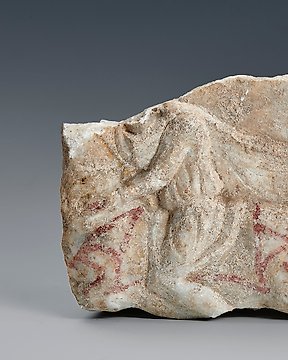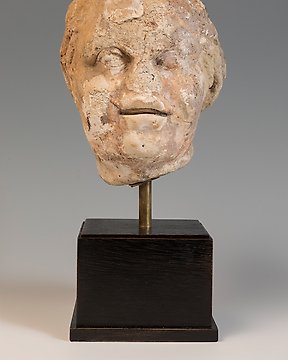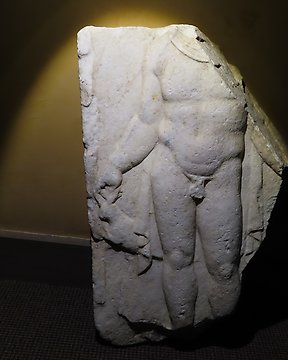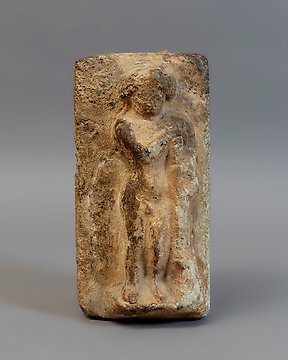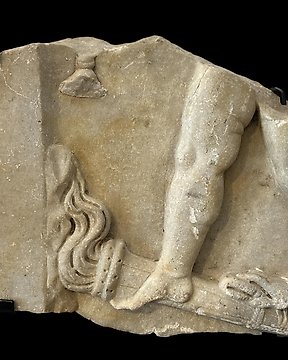
Romerska antiken Marmor Sarkofagrelief - 40.5 cm
Catawiki uppdaterar kontinuerligt sin teknik. Du använder för tillfället en gammal webbläsare. Uppdatera din webbläsare för att optimera din upplevelse.
Du kan ställa in dina cookie-inställningar med hjälp av knapparna nedan. Du kan uppdatera dina inställningar, ta tillbaka ditt samtycke när som helst och se en detaljerad beskrivning av de typer av cookies som vi och våra partners använder i vår Cookie-policy.
Nr 83895577

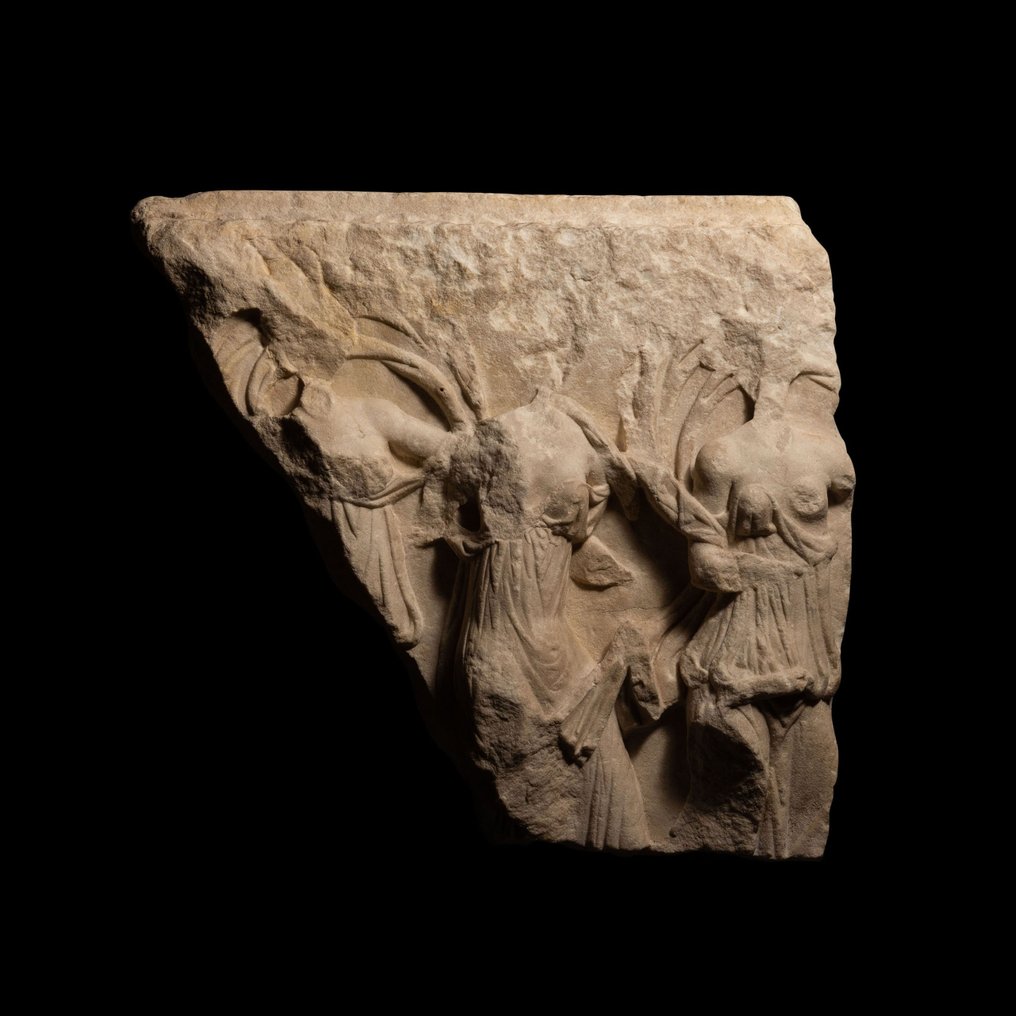
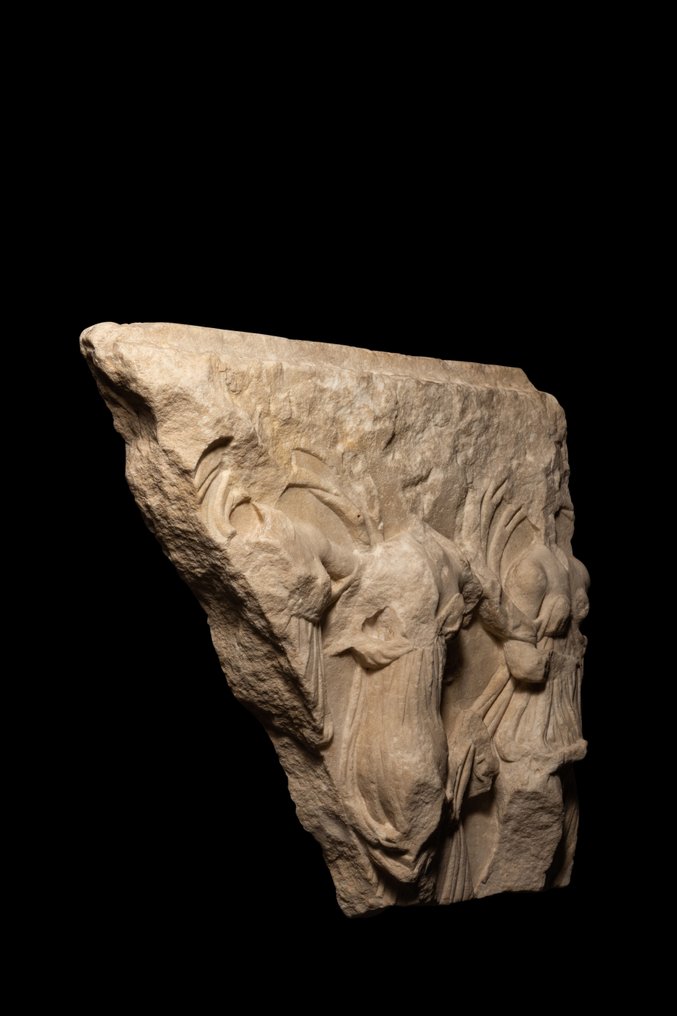
Sarcophagus Fragment with the Daughters of King Lycomedes
- Masterpiece! -
- Museum Parallels -
- Published -
Ancient Roman, 1st century BC- 1st century AD.
Marble.
Height 74 cm; width 79.5 cm and depth 18.3 cm
PROVENANCE:
- Sotheby & Co auction, London, 1972.
- Japan private collection.
CONDITION: Good state of conservation, without restorations.
PUBLICATION:
- Sotheby & Co, Catalogue of Egyptian, Western Asiatic, Greek, Etruscan and Roman Antiquities also Islamic Pottery. Londres. 27 de Marzo de 1972. Lote 184 (ilustrado en la plancha XVII).
BIBLIOGRAPHY:
- ELVIRA BARBA, M.A. Manual de iconografía clásica. Sílex. 2008.
- ESTACIO. Aquileida. Padilla Libros. 2012.
- FRIEDLAND, E.A.; SOBOCINSKI, M.G.; GAZDA, E.K. (eds). The Oxford Handbook of Roman Sculpture. Oxford University Press. 2015.
- GRIMAL, P. The Dictionary of Classical Mythology. Wiley-Blackwell. 1996.
- HOMERO. Ilíada. Gredos. 2019.
- KING, K.C. Achilles: Paradigms of the War Hero from Homer to the Middle Ages. University of California Press. 1987.
- KLEINER, Diana. Roman Sculpture. Yale University Press. 1992.
- KOUSSER, R.M. Hellenistic and Roman Ideal Sculpture: The Allure of the Classical. Cambridge University Press. 2008.
- NOCK, A.D. « Sarcophagi and Symbolism ». American Journal of Archaeology, vol. 50, nº 1 (jan.-mar. 1946), pp. 140-170.
- OVIDIO. Las metamorfosis. Cátedra. 2007.
- PEARCE, John. Death and burial in the Roman Age. Oxford University Press. 2020.
DESCRIPTION:
Trapezoidal relief fragment from a sarcophagus with three female figures, carved in high relief, dressed in a chiton and adorned with delicate veils. They are three young maidens, the one in the center with her torso leaning forward, in full movement. The girls appear with their shoulders and one of their breasts bare, and their chitons are so fine that they adhere to their bodies, revealing their slender anatomies. The folds multiply on their bodies, adding expressiveness and dynamism to the scene. Behind her, the veils rise lightly, moved by the breeze. They surround their heads and bodies, filling the space and adding agitation to the composition, in a similar way to what can be seen in two reliefs preserved in the Musée du Louvre, from a similar period (figs. 1 and 2). This set of fine and sinuous cloths can also be found in round sculptures, as is the case of a Victoria preserved in the British Museum (fig. 3).
This complex set of panels greatly contributes to the three-dimensional construction of the scene. The relief reflects the perspective effectively, reaching the high relief on the shoulders of the girls, and even the round shape on their heads, now lost. The folds of the veils behind her, on the other hand, are blurred, softening the transition between the different levels of relief. In this way, an almost atmospheric aspect of the space is constructed, harmonic and naturalistic, which does not seek the contrast between figure and background but rather the organic appearance of the composition. It is the same type of sculptural work that can be found in great Roman works of the same period, as is the case of the Ara Pacis (fig. 4).
The fragment comes from one of the sides of a monumental sarcophagus, where the scene of Achilles in the court of King Lycomedes was represented. There is another fragment of the same piece, in which Achilles appears disguised as a girl and accompanied by two of the princesses, who flee upon discovering his true identity (fig. 5). This story is part of the youth of Achilles, and precedes his march to the Trojan War. His mother, the Nereid Tethys, knew that her son was going to die in the fight, so she hid him in Esciros, in the court of King Lycomedes. There the boy remained hidden, disguised as a maiden, and fell in love with one of the princesses, the young Deidamía. When she became pregnant, Achilles took hold of her mother's decision to avoid war, decided to stay in the gynaeceum, in peace, and renounce the immortal glory of battle.
The seer Calchas had prophesied that without Achilles in his ranks, the Greeks could never defeat the Trojans. That is why, once his presence in Esciros is discovered, Ulysses and Diomedes will march in search of him, determined to bring him back with them. Arriving at the court of the king, the Greeks offered the young princesses all kinds of gifts, dresses and jewelry, among which, however, were several weapons. Seeing them, Achilles could not avoid launching himself after them, admiring them with an expert eye and thus revealing her true identity to the surprise of all the princesses except Deidamia, who knew then that he would never see her lover again. The young man betrays himself in the face of the impossibility of hiding his heroic nature, and once again demonstrates the pitfall of fighting against one's own destiny, a key theme throughout the Greek narrative.
Achilles was the greatest hero of the Trojan War, so in Greek and Roman times the images of him were frequent in all kinds of artistic representations, reaching the times of the Late Kingdom. In these scenes not only his heroic deeds were represented, but also his childhood and youth: Thetis's attempt to make him immortal, submerging him in the Styx lagoon supported by a heel; his education by the centaur Chiron and his presence among the daughters of Lycomedes.
According to Pliny in his Natural History, the theme of Achilles among the daughters of Lycomedes became popular in Antiquity through a Hellenistic painting by Atenión de Maronea. This original composition was the likely origin of various versions of the theme found in Pompeian paintings, sarcophagi, and mosaics from the Imperial Roman era. It will also be a relatively frequent theme in Roman sarcophagi. Among the various that appear decorated with scenes starring Achilles, several of them dedicate the front or one of its sides to the episode of Skyros. Perhaps the most complete, since it includes the figures on the lid and all their fronts, is the one preserved in the Beirut Museum and from Tire (fig. 6). In this case, Achilles is unmasked by hearing Ulysses' trumpet, another version of the classical texts, in a scene that appears on one of the short sides of the sarcophagus.
In the Musée du Louvre there is another fairly complete sarcophagus, with the subject of Achilles between the daughters of Lycomedes in the frontal plane (fig. 7). It is a scene of great compositional and expressive richness, full of detail and worked in very high relief. In the same museum there is a sarcophagus front with the same theme (fig. 8), worked with a somewhat lower relief but with the same desire to fill the space, seeking a plastic play and narrative. Rather more crudely executed than these two examples is another sarcophagus front (fig. 9), which shows Deidamia trying to snatch Achilles' weapons to prevent his departure. In this version of the image, only the princesses accompany Achilles, and neither Odysseus nor Lycomedes appear. The drama of Deidamia's despair is also the protagonist in another representation of a sarcophagus, in this case from the Getty Villa in Malibu (fig. 10). In the relief, Achilles still seems to be debating between his fate and his love. Fine fragments of the subject, from sarcophagi like the present piece, have also been preserved in the Ny Glyptothek in Copenhagen (fig. 11) and the Metropolitan Museum of Art in New York (fig. 12).
In the first, the finely carved cloths of the clothes take on a special prominence in a scene with multiple figures and a proliferation of motifs. In the second, on the other hand, only the armour, adorned with a gorgon's head on its chest, is the resounding presence, thrown by Odysseus at Achilles' feet.
Arthur Darby Nock explains that this predilection for stories of Achilles and other heroes in the ornamentation of Roman sarcophagi has its origins in the idea that any scene from remote antiquity, whether or not dramatic or funereal in theme, whether or not it could be set as a parallel to the figure of the deceased, added dignity to the memory of the deceased. These themes would have been chosen to adorn the sarcophagus because of their significance, as well as by way of reference to Greek antiquity. The author suggests that this construction of a mythical context in funerary art would therefore function as a means of heroifying and glorifying the deceased.
PARALLELS:
Fig. 1 Relief with maenad. Roman Kingdom, 1st century AD. Marble. Musee du Louvre, Paris. Inv. Ma709.
Fig. 2 Relief fragment with maenads. Roman Kingdom, 1st century AD. Marble. Musée du Louvre, Paris, Inv. Ma3626.
Fig. 3 Fragment of Victoria in marble. Roman or Hellenistic Kingdom, from Halicarnassus, 1st century BC. British Museum, London. Inv. 1857,1220.334.
Fig. 4 Relief with Tellus Mater from the Ara Pacis, years 13-9 B.C. Museo dell'Ara Pacis, Rome.
Fig. 5 Fragment of the same sarcophagus, with Achilles uncovered taking the weapons offered by Ulysses. Auctioned at Sotheby's London on March 27, 1972, lot 183.
Fig. 6 Side of sarcophagus with Achilles among the daughters of Lycomedes, listening to the war trumpet carved in marble. Roman Kingdom of Tyre, Lebanon, 3rd century AD. Beirut National Museum. Inv. 607.
Fig. 6 Side of sarcophagus with Achilles among the daughters of Lycomedes, listening to the war trumpet carved in marble. Roman Kingdom of Tyre, Lebanon, 3rd century AD. Beirut National Museum. Inv. 607.
Fig. 7. Sarcophagus with the same theme. Roman Kingdom, 210-220 AD Marble. Musee du Louvre, Paris. Inv. Ma3570.
Fig. 8. Front of sarcophagus with Achilles among the daughters of Lycomedes. Roman Kingdom, from an Attic workshop, c. AD 240 Musee du Louvre, Paris. Inv. Ma2120.
Fig. 9. Sarcophagus with the same theme made in marble. Roman Kingdom, AD 200-230. British Museum, London. Inv. 1805,0703.154.
Fig. 10. Side of sarcophagus with the same theme carved in marble. Roman Kingdom from an Attic workshop, 180-220 AD. The Getty Villa, Malibu. Inv. 95.AA.80.1.
Fig. 11. Fragment of a sarcophagus with the same theme carved in marble. Roman Kingdom. Ny Carlsberg Glyptothek, Copenhagen.
Fig. 12. Lower right corner of a sarcophagus with the theme of Achilles discovered by Ulysses. It shows a breastplate and two feet. Roman Kingdom, 160-180 AD. Marble. Metropolitan Museum of Art, New York. Inv. 18.145.41.
Notes:
The piece includes authenticity certificate.
The piece includes Spanish Export License (Passport for European Union) - If the piece is destined outside the European Union a substitution of the export permit should be requested. This process could take between 1 and 2 weeks.
Sarcophagus Fragment with the Daughters of King Lycomedes
- Masterpiece! -
- Museum Parallels -
- Published -
Ancient Roman, 1st century BC- 1st century AD.
Marble.
Height 74 cm; width 79.5 cm and depth 18.3 cm
PROVENANCE:
- Sotheby & Co auction, London, 1972.
- Japan private collection.
CONDITION: Good state of conservation, without restorations.
PUBLICATION:
- Sotheby & Co, Catalogue of Egyptian, Western Asiatic, Greek, Etruscan and Roman Antiquities also Islamic Pottery. Londres. 27 de Marzo de 1972. Lote 184 (ilustrado en la plancha XVII).
BIBLIOGRAPHY:
- ELVIRA BARBA, M.A. Manual de iconografía clásica. Sílex. 2008.
- ESTACIO. Aquileida. Padilla Libros. 2012.
- FRIEDLAND, E.A.; SOBOCINSKI, M.G.; GAZDA, E.K. (eds). The Oxford Handbook of Roman Sculpture. Oxford University Press. 2015.
- GRIMAL, P. The Dictionary of Classical Mythology. Wiley-Blackwell. 1996.
- HOMERO. Ilíada. Gredos. 2019.
- KING, K.C. Achilles: Paradigms of the War Hero from Homer to the Middle Ages. University of California Press. 1987.
- KLEINER, Diana. Roman Sculpture. Yale University Press. 1992.
- KOUSSER, R.M. Hellenistic and Roman Ideal Sculpture: The Allure of the Classical. Cambridge University Press. 2008.
- NOCK, A.D. « Sarcophagi and Symbolism ». American Journal of Archaeology, vol. 50, nº 1 (jan.-mar. 1946), pp. 140-170.
- OVIDIO. Las metamorfosis. Cátedra. 2007.
- PEARCE, John. Death and burial in the Roman Age. Oxford University Press. 2020.
DESCRIPTION:
Trapezoidal relief fragment from a sarcophagus with three female figures, carved in high relief, dressed in a chiton and adorned with delicate veils. They are three young maidens, the one in the center with her torso leaning forward, in full movement. The girls appear with their shoulders and one of their breasts bare, and their chitons are so fine that they adhere to their bodies, revealing their slender anatomies. The folds multiply on their bodies, adding expressiveness and dynamism to the scene. Behind her, the veils rise lightly, moved by the breeze. They surround their heads and bodies, filling the space and adding agitation to the composition, in a similar way to what can be seen in two reliefs preserved in the Musée du Louvre, from a similar period (figs. 1 and 2). This set of fine and sinuous cloths can also be found in round sculptures, as is the case of a Victoria preserved in the British Museum (fig. 3).
This complex set of panels greatly contributes to the three-dimensional construction of the scene. The relief reflects the perspective effectively, reaching the high relief on the shoulders of the girls, and even the round shape on their heads, now lost. The folds of the veils behind her, on the other hand, are blurred, softening the transition between the different levels of relief. In this way, an almost atmospheric aspect of the space is constructed, harmonic and naturalistic, which does not seek the contrast between figure and background but rather the organic appearance of the composition. It is the same type of sculptural work that can be found in great Roman works of the same period, as is the case of the Ara Pacis (fig. 4).
The fragment comes from one of the sides of a monumental sarcophagus, where the scene of Achilles in the court of King Lycomedes was represented. There is another fragment of the same piece, in which Achilles appears disguised as a girl and accompanied by two of the princesses, who flee upon discovering his true identity (fig. 5). This story is part of the youth of Achilles, and precedes his march to the Trojan War. His mother, the Nereid Tethys, knew that her son was going to die in the fight, so she hid him in Esciros, in the court of King Lycomedes. There the boy remained hidden, disguised as a maiden, and fell in love with one of the princesses, the young Deidamía. When she became pregnant, Achilles took hold of her mother's decision to avoid war, decided to stay in the gynaeceum, in peace, and renounce the immortal glory of battle.
The seer Calchas had prophesied that without Achilles in his ranks, the Greeks could never defeat the Trojans. That is why, once his presence in Esciros is discovered, Ulysses and Diomedes will march in search of him, determined to bring him back with them. Arriving at the court of the king, the Greeks offered the young princesses all kinds of gifts, dresses and jewelry, among which, however, were several weapons. Seeing them, Achilles could not avoid launching himself after them, admiring them with an expert eye and thus revealing her true identity to the surprise of all the princesses except Deidamia, who knew then that he would never see her lover again. The young man betrays himself in the face of the impossibility of hiding his heroic nature, and once again demonstrates the pitfall of fighting against one's own destiny, a key theme throughout the Greek narrative.
Achilles was the greatest hero of the Trojan War, so in Greek and Roman times the images of him were frequent in all kinds of artistic representations, reaching the times of the Late Kingdom. In these scenes not only his heroic deeds were represented, but also his childhood and youth: Thetis's attempt to make him immortal, submerging him in the Styx lagoon supported by a heel; his education by the centaur Chiron and his presence among the daughters of Lycomedes.
According to Pliny in his Natural History, the theme of Achilles among the daughters of Lycomedes became popular in Antiquity through a Hellenistic painting by Atenión de Maronea. This original composition was the likely origin of various versions of the theme found in Pompeian paintings, sarcophagi, and mosaics from the Imperial Roman era. It will also be a relatively frequent theme in Roman sarcophagi. Among the various that appear decorated with scenes starring Achilles, several of them dedicate the front or one of its sides to the episode of Skyros. Perhaps the most complete, since it includes the figures on the lid and all their fronts, is the one preserved in the Beirut Museum and from Tire (fig. 6). In this case, Achilles is unmasked by hearing Ulysses' trumpet, another version of the classical texts, in a scene that appears on one of the short sides of the sarcophagus.
In the Musée du Louvre there is another fairly complete sarcophagus, with the subject of Achilles between the daughters of Lycomedes in the frontal plane (fig. 7). It is a scene of great compositional and expressive richness, full of detail and worked in very high relief. In the same museum there is a sarcophagus front with the same theme (fig. 8), worked with a somewhat lower relief but with the same desire to fill the space, seeking a plastic play and narrative. Rather more crudely executed than these two examples is another sarcophagus front (fig. 9), which shows Deidamia trying to snatch Achilles' weapons to prevent his departure. In this version of the image, only the princesses accompany Achilles, and neither Odysseus nor Lycomedes appear. The drama of Deidamia's despair is also the protagonist in another representation of a sarcophagus, in this case from the Getty Villa in Malibu (fig. 10). In the relief, Achilles still seems to be debating between his fate and his love. Fine fragments of the subject, from sarcophagi like the present piece, have also been preserved in the Ny Glyptothek in Copenhagen (fig. 11) and the Metropolitan Museum of Art in New York (fig. 12).
In the first, the finely carved cloths of the clothes take on a special prominence in a scene with multiple figures and a proliferation of motifs. In the second, on the other hand, only the armour, adorned with a gorgon's head on its chest, is the resounding presence, thrown by Odysseus at Achilles' feet.
Arthur Darby Nock explains that this predilection for stories of Achilles and other heroes in the ornamentation of Roman sarcophagi has its origins in the idea that any scene from remote antiquity, whether or not dramatic or funereal in theme, whether or not it could be set as a parallel to the figure of the deceased, added dignity to the memory of the deceased. These themes would have been chosen to adorn the sarcophagus because of their significance, as well as by way of reference to Greek antiquity. The author suggests that this construction of a mythical context in funerary art would therefore function as a means of heroifying and glorifying the deceased.
PARALLELS:
Fig. 1 Relief with maenad. Roman Kingdom, 1st century AD. Marble. Musee du Louvre, Paris. Inv. Ma709.
Fig. 2 Relief fragment with maenads. Roman Kingdom, 1st century AD. Marble. Musée du Louvre, Paris, Inv. Ma3626.
Fig. 3 Fragment of Victoria in marble. Roman or Hellenistic Kingdom, from Halicarnassus, 1st century BC. British Museum, London. Inv. 1857,1220.334.
Fig. 4 Relief with Tellus Mater from the Ara Pacis, years 13-9 B.C. Museo dell'Ara Pacis, Rome.
Fig. 5 Fragment of the same sarcophagus, with Achilles uncovered taking the weapons offered by Ulysses. Auctioned at Sotheby's London on March 27, 1972, lot 183.
Fig. 6 Side of sarcophagus with Achilles among the daughters of Lycomedes, listening to the war trumpet carved in marble. Roman Kingdom of Tyre, Lebanon, 3rd century AD. Beirut National Museum. Inv. 607.
Fig. 6 Side of sarcophagus with Achilles among the daughters of Lycomedes, listening to the war trumpet carved in marble. Roman Kingdom of Tyre, Lebanon, 3rd century AD. Beirut National Museum. Inv. 607.
Fig. 7. Sarcophagus with the same theme. Roman Kingdom, 210-220 AD Marble. Musee du Louvre, Paris. Inv. Ma3570.
Fig. 8. Front of sarcophagus with Achilles among the daughters of Lycomedes. Roman Kingdom, from an Attic workshop, c. AD 240 Musee du Louvre, Paris. Inv. Ma2120.
Fig. 9. Sarcophagus with the same theme made in marble. Roman Kingdom, AD 200-230. British Museum, London. Inv. 1805,0703.154.
Fig. 10. Side of sarcophagus with the same theme carved in marble. Roman Kingdom from an Attic workshop, 180-220 AD. The Getty Villa, Malibu. Inv. 95.AA.80.1.
Fig. 11. Fragment of a sarcophagus with the same theme carved in marble. Roman Kingdom. Ny Carlsberg Glyptothek, Copenhagen.
Fig. 12. Lower right corner of a sarcophagus with the theme of Achilles discovered by Ulysses. It shows a breastplate and two feet. Roman Kingdom, 160-180 AD. Marble. Metropolitan Museum of Art, New York. Inv. 18.145.41.
Notes:
The piece includes authenticity certificate.
The piece includes Spanish Export License (Passport for European Union) - If the piece is destined outside the European Union a substitution of the export permit should be requested. This process could take between 1 and 2 weeks.
